
When was the first drone? The first real drone was built in 1917 to counter German bombers or to deliver bombs.
Drones are technically known as unmanned aerial vehicles (UAV) and drone is more of a nickname. They became known as drones in 1946, but the name came from one of the first successful drones that flew in 1935, which was a De Havilland DH.82B Queen Bee aircraft. The drone was named after the bee drones. They are heavier than worker bees and they tend to be driven and mindless. Drone planes are the same. It is probable that if the first unmanned aerial vehicle hadn’t been called “Queen Bee”, UAVs wouldn’t be called drones today.
There is a long history of unmanned aerial vehicles, but the first controllable flying drone was the one flown in 1935. The very first drones were balloons, launched in the 1780s. The first hot air balloon was flown on September 19, 1783, and it was an unmanned vehicle. It was flown by Pilatre De Rozier, and he didn’t want to risk his own life, so he sent it up with a sheep, a duck, and a rooster. Unmanned hot air balloons are very easy to launch, but they are impossible to steer. They are completely at the mercy of the winds. In 1849, an Austrian lieutenant used balloons to carry bombs over the city walls of Venice. The winds were uncontrollable and the bombs were nowhere near as effective as he’d hoped.
Before a drone was possible, a system of controlling them was necessary. Nikola Tesla was the first person to make a radio-controlled craft when he released his radio-controlled boat in 1898. It was powered with batteries and had switches that operated the propeller, rudder, and lights when they received an electric signal. Tesla invented a radio switch for the purpose that was a canister with metal oxide powder in it. When there was an electromagnetic field, such as that created by radio waves, the powder moved in line with the field and became conductive, operating the switch. People who saw the boat moving thought it was magic.
This radio-controlled technology was improved upon and by the beginning of the First World War, Britain used it to remotely control boats that could be sailed out from a mother ship and they also experimented with radio-controlled planes. There are design plans left from a radio-controlled plane I n1914, but there is no evidence that it was built. The first real radio-controlled planes were built in 1917 and the very first one to fly, the very first drone, flew on 21st March, 1917. Many of them crashed on take-off, but a few were successful. The hope was that they could be flown into enemy planes, or they could be filled with explosives and flown behind enemy lines. At the same time, Americans were experimenting with pilotless planes and they came up with the Kettering Bug, which as the forerunner of a modern cruise missile. It was a modified plane that was basically a flying torpedo that could be controlled. The war ended before they could ever be used.
The first fully controllable drone was developed in 1935 in Britain. This was the DH.82B Queen Bee that the drone is named after. It was invented for target practice. Pilots trained by shooting at gliders that were pulled behind planes and then released, but they weren’t very effective targets because their motion was very predictable. The heads of the RAF wanted training planes that could move and mimic real planes in a real dogfight. The DH.82B was invented or this purpose. A US admiral saw the Queen Bee in action and started he US drone program when he returned home. This could be where the word drone became popular because they used it to refer to the Queen Bee.
In the wars of the 1970s more drones were used because the loss of pilots was not something belligerents could deal with. Once it became possible to send a drone in instead of a pilot, that became the more sensible thing to do. During the Cold War, drones became more powerful and were used for intelligence gathering. Remote video feeds meant that a line of sight to the drone wasn’t necessary, and they could be flown from almost anywhere. In the late 1990s and onwards, camera technology improved to the point where the cameras were very light weight and the size and weight of batteries decreased. Drones could fly further and take increasingly better video footage. Then, improvements in software, cameras, sensors, and artificial intelligence have meant that drones can become autonomous. They can be used to deliver parcels, track a skier down a mountain, or find targets on a battlefield. They have come a long way. And this is what I learned today.
Image By Lt. Col. Leslie Pratt – MQ-9 Reaper UAV.jpg, Public Domain, https://commons.wikimedia.org/w/index.php?curid=68095681
Sources
https://consortiq.com/uas-resources/short-history-unmanned-aerial-vehicles-uavs
https://www.iwm.org.uk/history/a-brief-history-of-drones
https://en.wikipedia.org/wiki/British_unmanned_aerial_vehicles_of_World_War_I
https://en.wikipedia.org/wiki/Kettering_Bug
https://en.wikipedia.org/wiki/Unmanned_aerial_vehicle
https://www.pix4d.com/blog/etymology-drone-photogrammetry/
https://www.etymonline.com/word/drone
